What's Up With the Roof?
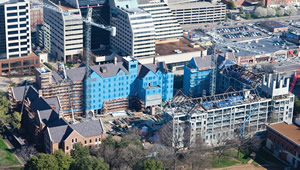
PHOTO COURTESY OF RSS ROOFING SERVICES & SOLUTIONS
As school buildings age, campus administrators and facility managers face the growing challenge of maintaining facilities at a level that enables instructors to meet the needs of the student body. While the construction of new school facilities supports this task, many older buildings have deteriorated over time. The responsibility of caring for older school buildings, some of which are historically or architecturally significant, at a level that supports instructional practices, is fundamental.
Colleges and universities are working harder to keep their buildings in good condition, but shrinking resources are impeding these efforts. Costs to operate, maintain, and repair older campus facilities that are in poor condition increase year after year. As the buildings get older and continue to deteriorate, the more it costs to maintain the buildings and prevent further damage.
The Role of the Roof: Failure and Safety Concerns
One of the most important features of a building is its roof. The primary function of the roof is to provide protection from the outside elements and give adequate provision for thermal and sound insulation and fire performance. Roofs are at the top of the damage chain for education facilities. With a failing roof the damage is immediate, and the results can be catastrophic. When a roof leaks, it results in structural damage to walls and floors, as well as damage to insulation and mechanical and electrical systems.
A properly maintained roof not only protects the building itself but also the occupants inside. The building owner is responsible for the well being of the building’s occupants and is liable for problems such as injuries that occur on the premises. A neglected roof can create numerous safety concerns. Deferred maintenance and repairs can lead to leaks and water infiltration. Leaks can cause falling debris from sagging ceilings and walls, cause slips and falls, and even lead to electrical shock. Water damage alone can lead to severe injuries to the building occupants. When water infiltration occurs, it can damage the insulation within the roof and walls, causing mold and fungus to grow, negatively affecting occupants’ health. Water infiltration eventually leads to mold, and abatement is expensive and time consuming.
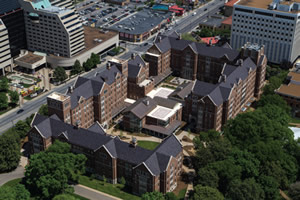
PHOTO COURTESY OF RSS ROOFING SERVICES & SOLUTIONS
To ensure the safety of students, staff, and visitors, school roofs require proper maintenance to avoid damage and to extend the life of the roof. A correctly implemented maintenance plan provides comfort and confidence for the future of the campus. A sound facilities maintenance plan serves as evidence that campus facilities are cared for appropriately.
Funding a Roof Maintenance Program
Deferred maintenance is a challenge that many colleges and universities around the country are facing. As funding tightens, the facilities maintenance department is typically among the first required to make do with less funding. Many institutions opt to allocate capital to more visible programs, leaving roof maintenance needs unmet for far too long. The resulting deferred maintenance may save money in the short term, but in the long run can lead to higher costs, as poorly maintained roof systems burn out before its life expectancy.
Funding a roof maintenance and repair plan is necessary and will substantially reduce the number of emergency responses. A maintenance program provides all employees and students with a safe, secure, clean, and aesthetically pleasant physical environment that is conducive to learning.
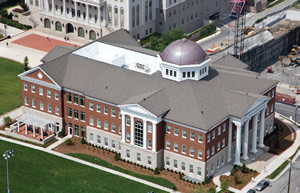
PHOTO COURTESY OF RSS ROOFING SERVICES & SOLUTIONS
A good roof maintenance plan costs money. The return on expenditure will result in lower future maintenance costs and extend the service life of the existing roof. Roof maintenance produces savings by decreasing equipment replacement costs over time; decreasing renovation costs because fewer large-scale repair or replacement works are required; and decreasing overhead costs, such as utility bills, because of increased system efficiency. The roof should be treated as an asset and be properly managed.
Roof Inspections
A regular program of both roof inspections and maintenance will help detect minor problems before they become serious, avoid interruptions of the internal functions within the building and, most importantly, protect the investment by adding years to the life of the roof.
There are three types of roof inspections that must be performed: the initial inspection, the seasonal inspection, and the damage inspection. The initial inspection verifies that the roof has been properly installed and is free of defects. It identifies where equipment was installed and ensures that the equipment has been installed in such a way that its operation will not damage the roof. It also records the location of any other roof penetrations for future monitoring, as well as ensuring that the roof is properly sealed around the penetrations and secured at perimeters.
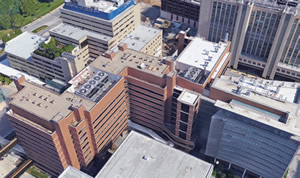
PHOTO COURTESY OF RSS ROOFING SERVICES & SOLUTIONS
Seasonal inspections should typically be performed twice a year—in the fall and in the spring—for climates with four distinct seasons. The timing of these inspections is essential. The fall inspection is designed to identify defects that may have formed over the summer when the roof was exposed to high thermal stresses. The spring inspection looks for problems that may have been caused by ice or snow accumulation, or damage from the wind.
Damage inspections are performed immediately following severe weather, such as heavy snow fall or hail storms and tornadoes or high winds. The evaluation should include looking for signs of water infiltration, removing debris from the roof (especially near drainage areas) and, if damage is present, the roof assembly should be considered for replacement through an insurance claim. In the meantime, your roofing contractor can temporarily repair leaks until a full repair is possible. It is important to make temporary repairs as soon as possible following a severe weather event. Post-weather maintenance will minimize damage to the interior from water stains condensation and mold.
Repair or Replace
The roof is one of the most expensive components of any building and for that reason, when a problem arises, key decisions makers should first consider whether to repair or replace it. Understanding the primary cost factors involved in a commercial roof replacement can help in that decision, as well as in deciding what type of replacement to choose and how much to budget. Bringing the existing roof up to the most recent building code requirements should also be evaluated.
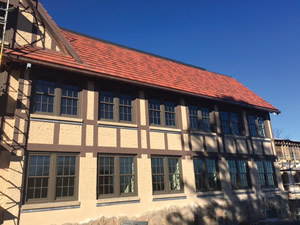
PHOTO COURTESY OF RSS ROOFING SERVICES & SOLUTIONS
STAY ON TOP OF THINGS. Problems with roofing do not usually happen overnight (severe weather events excluded). A trained inspector can spot problems before they go too far. By the time you notice a leak, there may already be structural damage to the roof, damage to equipment and inventory, or mold. In addition, it can take more time and effort to correct a problem once it’s progressed.
All roofs have an expected useful life, depending on the type of roof, materials used, climate conditions, and the type of building the roof is on. The nearer the roof is to the end of its expected useful life, the more likely a replacement is the most cost-effective option. Cost of repair also plays a role. A very inexpensive repair may be worthwhile even on a roof near the end of its useful life.
A common mistake to note is that building owners and facility managers often assume that if leaks occur repeatedly, the entire roof is faulty and should be replaced. Repeat leaks often have more to do with installation errors than the roof itself, and a proper repair can be a much lower-cost option.
The first place to look when this happens is at any penetrations in the roof. Penetrations are areas where holes are punched through the roof, such as mechanical equipment stands or service conduits. If leaks are occurring at a penetration, then it probably wasn’t properly installed. Depending on the number of penetrations, it’s likely that repairing the flashing will fix the problem much more efficiently than a complete replacement.
Replacing a roof on a commercial building is a considerable investment, and rarely in the budget. Therefore, routine roof inspections and maintenance programs are critical. A successful roof inspection and maintenance program should consist of periodic inspections and regularly scheduled maintenance. A roof inspection and maintenance program will reduce ownership costs, reduce leak frequency and severity, extend the life of the roof, and reduce maintenance inefficiencies.
Choose a Roofing Contractor
A roof is more than a component of a building; it’s an asset, investment, and a commitment. Nothing can compromise the integrity of a structure faster than the improper maintenance and repair of a roof system. Therefore, the first item on the list for the facility manager is vetting potential commercial roofing contractors. It is imperative that the commercial roofing contractor follows best business practices—including being legally licensed, bonded, and insured—receives positive client testimonials, and provides a long business history with a proven track record.
Facility managers should conduct their own research about the optimal roof systems for their commercial buildings. However, the roofing contractor will be able to supplement that research with extensive knowledge of the type of roof system that is best for the building’s location and its intended use. Additionally, the facility manager should hire a commercial roofing contractor that has extensive experience with all types of roof systems.
This article originally appeared in the College Planning & Management March 2018 issue of Spaces4Learning.